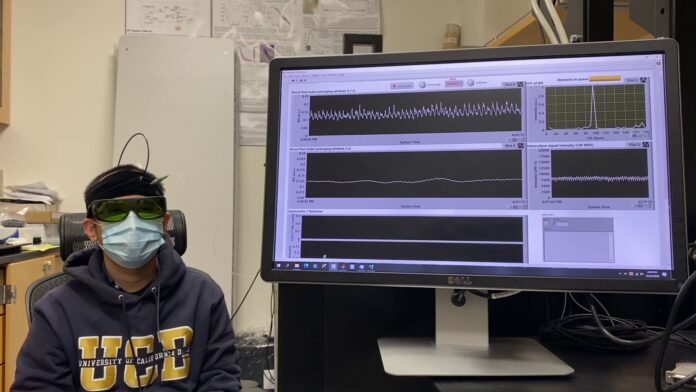Engineers and neurologists collaborate to create a device that could help brain injury and stroke patients
Cerebral blood flow (CBF) is essential to human brain functioning, and yet current imaging techniques are costly and usually do not provide continuous measurements for physicians. Recognizing this problem, Vivek Srinivasan, an adjunct associate professor of biochemical engineering at UC Davis, and his team have developed a method to measure cerebral blood flow non-invasively—functional interferometric diffusing wave spectroscopy (fidWS).
“fiDWS can assess optical BFI signals, driven either by neural activity or cerebrovascular reactivity, with an unmatched combination of speed and brain specificity,” said Wenjun Zhou, an assistant project scientist in the Department of Biomedical Engineering at UC Davis and the first author of the study, via email. “The methodology and its variants are projected to achieve increasingly competitive cost.”
Ryan Martin, an assistant professor in the Department of Neurology at the UC Davis Medical Center explained that there are a number of current methods to measure CBF, such as through transcranial dopplers which measure the velocity of blood flow in the brain, or CT perfusion scans. There are also indirect methods to measure CBF, such as by subtracting the intracranial pressure measurement from the mean arterial pressure in the body. However, Martin elaborated that the main problem with current methods being used is that they are not very practical—some can only be used once or twice a day or require intensive labor to perform.
In order to develop this new method, Zhou explained that their team used the knowledge that near-infrared light can propagate diffusively in the adult human brain through the scalp where it can be collected and measured. Through the use of near-infrared light-based Diffusing Wave Spectroscopy (DWS) and Diffuse Correlation Spectroscopy (DCS), experimenters are able to derive a blood flow index (BFI) which serves as a surrogate for CBF. Zhou stated that DWS/DCS can perform continuous optical BFI monitoring of the adult human brain with relatively low instrument cost.
However, this technique also comes with a drawback—there is a limit to the signal-to-noise ratio that can be achieved, contaminating desired brain signals. According to their published paper, “Extracerebral contamination can confound results in neurosurgery if weakly regulated scalp blood flow is mistaken for dysregulated CBF, or in a brain-computer interface, where an incorrect decision is made in response to a systemic, corrupting physiological change.” Thus, in order to optimize their fiDWS system, Zhou explained he and his team spent multiple years engineering and developing it to ensure the final quality.
“In fiDWS, we use a strong coherent reference light to boost (interfere) weak sample light from the brain, so that the interference signal, containing sample dynamics information (i.e. BFI), can be directly measured by a non-scientific CMOS sensor,” Zhou said via email.
Martin explained that there are multiple clinical advantages to the fiDWS method, such as the increased opportunity to manipulate blood pressure and to make sure the cerebral blood flow stays within the desired range. He emphasized that such functions are necessary to make sure the brain continues to be metabolically active by having a constant blood flow.
“How we’re going to use this [device] clinically is it’s still very rudimentary, but it allows us to titrate blood pressure parameters on patients,” Martin said. “We can use it to assess reperfusion after someone’s had a stroke and they’ve gotten to remove the blood clot that’s causing the stroke. So there’s lots of practical things that the NIRS [near-infrared spectroscopy] device that we use now, or have used, doesn’t really provide.”
Martin explained that the engineers are currently looking for ways to make the device smaller and more practical to be taken into a patient’s room to use. He believes that with time, they will be able to start testing the device on patients to collect data on how well it functions. Martin added that he thinks there is certainly opportunity for the fiDWS device to be used as a treatment and diagnostic tool in neurocritical care.
“Beyond monitoring in cardiac surgery, neurotrauma, ischemic stroke and neonatal intensive care, fiDWS promises to facilitate assessing CBF at the point of care, in athletes or soldiers after head injury, and possibly even in portable devices that monitor brain activity,” Zhou said via email.
Written by: Michelle Wong — science@theaggie.org




